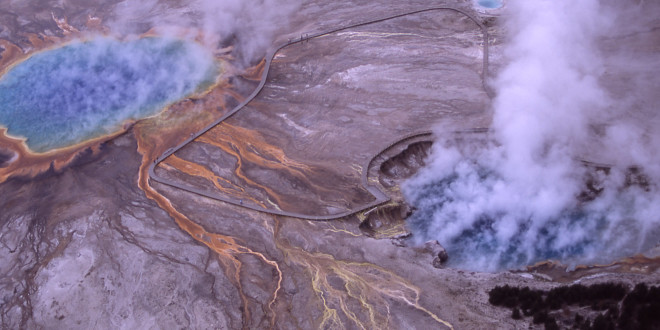If you think you’ve got Yellowstone’s magma plume figured out, you may have another thing coming.
Indeed, the plume may not play much of a role in Yellowstone’s thermal landscape—or its volcanic potential.
According to new research to be published in Geophysical Research Letters, what lies beneath Yellowstone is far different than previous projections show. To wit: instead a straight shot of molten rock pushing up under the surface, an immense slab of tectonic rock caps off most of the plume.
The finding flies in the face of the previous theory, which holds the plume as a central force in driving Yellowstone. In fact, study authors Tiffany Leonard and Lijun Liu (both affiliated with the Department of Geology at the University of Illinois at Urbana-Champaign) go so far as to say in their abstract: “We suggest that a plume is likely to have much less influence on the Yellowstone volcanism than previously thought.” From Science News:
Over the last 16.5 million years, the hot spot under Yellowstone has fueled a string of supervolcanic eruptions. The most recent eruption around 640,000 years ago spewed enough debris to fill Lake Erie two times (SN: 10/4/14, p. 32). But long before that — around 200 million years ago — the converging Pacific and North American plates began forcing a slab of ocean crust called the Farallon Plate underground. Previous explanations of Yellowstone’s origins ignored this sunken plate, Liu says.
Simulating both the plume and the Farallon Plate together, Liu and geophysicist Tiffany Leonard retraced North America’s underground history. The work showed that some hot rock squirted through a crack in the plate around 15 million years ago, fueling a volcanic eruption. After that event, though, the relatively cool plate largely barred the plume’s heat from rising above a depth of about 300 kilometers and fueling any of the future eruptions.
The result demonstrates that the ancient tectonic slab is the dominant player beneath North America, says Eugene Humphreys, a geophysicist at the University of Oregon in Eugene who was not involved with the work. “The plume is really at the whim of the slab,” Humphreys says.
Liu added to Science News that more research is needed if scientists want to understand how Yellowstone’s thermal landscape came to be. One possible hypothesis is the shifting of rock layers just below the surface. And before you ask, Leonard and Liu’s paper does not up the chances Yellowstone will blow in the near future.
What is the magma plume?
Prior research into the Yellowstone magma plume has revealed several insights. In the first place, according to a study published last spring in Science, there’s actually two parts to the plume: one shallow chamber near the surface and a larger, deeper reservoir. Second, the magma plume isn’t pure molten rock: more like a hot sponge, with pockets of molten rock surrounded by springy material. Third, the system is enormous, with enough material to fill the Grand Canyon 11.2 times over.
 Yellowstone Insider Your Complete Guide to America's First National Park
Yellowstone Insider Your Complete Guide to America's First National Park





